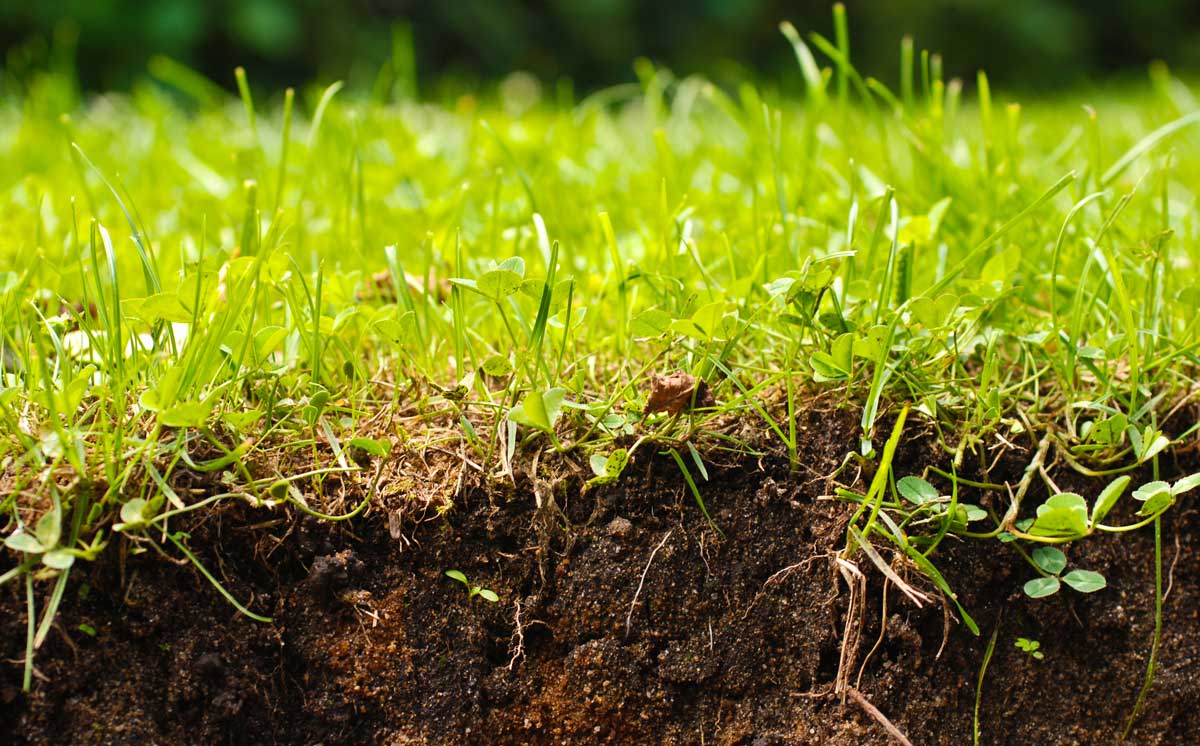Why is thatch is bad for your patch and how scarifying your lawn can lead to a better looking garden.
If you’ve watched my YouTube videos you’ll probably have seen Daniel and I busying ourselves with the lawn scarifier. It’s something we do at least once a year for most of our clients. Aand it really does make an enormous difference to their lawns. OK, I’ll admit, a freshly scarified lawn is not a thing of beauty. However, it will recover quickly and within a month you’ll be glad that you did it.
Scarifying gets all of the thatch out of a lawn. It’s like grooming your pet in the middle of moulting season. Once all of that unwanted fur is combed out, their coat will regain its shine. So what IS lawn thatch and where does it come from?
What Is Lawn Thatch?
Lawn thatch is something that you might not notice unless you get down on your knees and rummage amongst the blades of grass. It’s a layer of tightly packed debris that sits on top of the soil and is mostly hidden by the grass.

That straw-like pale brown layer between the green plants and the soil is called thatch. It looks and behaves a little bit like a thatched roof because it stops water soaking into the soil. Just one reason why thatch is bad for your patch.
Thatch is perfectly natural. It’s part of Mother Nature’s scheme to recycle dead plant material and turn it into organic matter that will enrich the soil. The difference between a lawn and uncultivated landscape is that in a lawn, the plants grow really close together. That results in more debris than the soil microbes can cope with and so it piles up to create the thatch layer. (A bit like NHS patients cueing for operations).
Along with cuttings that didn’t make it into the grass box and dead blades of grass there’ll be moss, a few dead insects and maybe even the remains of your summer picnics. When those things are all knitted together they create something similar to one of those old fashioned coir door mats. Nothing much can grow through it and water tends to sit on top of it rather than seeping through into the soil.
Why Is Thatch Bad For My Patch?
A small amount of thatch is actually quite good for your lawn. It’s part of Nature’s plan and it will eventually break down into it’s chemical components and improve your soil structure. Too much thatch though is a bad thing. It threatens to overpower the grass plants and doesn’t give them enough room to grow to their full potential.
I’ve already mentioned that thatch slows down absorption of rainwater and that in itself is bad enough. But did you also know that the microbes that cause diseases such as red thread disease and fusarium patch disease, actually live in the thatch layer? Most of the time they are happy munching on the dead and dying leaves in this layer, but when conditions are right, their populations increase and they start to attack the living parts of the plant too. So by removing excess thatch, you are also helping to control common lawn diseases.
How Do I Get Rid Of Thatch?
I’m afraid there’s no easy solution to getting rid of thatch. You can’t melt it away with chemical treatments, you have to get physical with it. And that’s what’s known as scarifying.
Scarifying scratches all of that moss and dead material out of your lawn. It loosens it and lifts it so that you can rake it all up and take it away. Traditionally it’s always been done with a spring tine rake, but thankfully, modern man has invented the mechanical scarifier. And now the job is much easier.
You can hire a scarifier from most tool hire shops or alternatively, why not get in touch with your local lawn care service and let someone else do the hard work?
Scarifying will give the living plants a bit of a shock. So it’s best done in spring and autumn when growing conditions are ideal and the plants don’t have any other challenges to deal with. That way the grass can recover quickly before it starts making the most of all the extra space you’ve provided. And indeed you want the grass to very quickly fill in any spaces you’ve made by scarifying. Mother Nature hates bare soil and if the grass doesn’t fill it, she’ll find something else that will!
How To Scarify Your Lawn
In this video I’m demonstrating how to scarify your lawn. I’ll show you two ways to tackle the job. And when you see how much debris gets pulled out from the lawn, you’ll be able to understand why thatch is bad for your patch.
The lawn in the video is my own lawn, it gets scarified once a year and is also regularly treated for moss. So the thatch layer in this lawn is relatively small. If your own lawn hasn’t been scarified for a while, don’t be surprised at the amount of debris that the scarifier removes. In fact, I’d recommend you take two (or even three) passes with the scarifier, lowering the blade a little each time.
These articles also talk about lawn scarifying – you might find them helpful
How To Prepare Your Lawn For Overseeding.

